India and China: A Comparative Analysis of Equality under the Law
VerifiedAdded on 2019/09/21
|7
|2150
|385
Essay
AI Summary
This essay provides a comparative analysis of the rule of equality in India and China, focusing on the differences between their political and legal systems. The paper begins by defining and contrasting the one-party system of China with the multi-party system of India, setting the stage for a discussion on equality before the law. It examines how each country's constitution and legal framework address equality, highlighting the specific provisions and interpretations related to equal treatment for all citizens. The essay then compares the practical application of equality laws in both countries, citing examples such as gender rights and property laws, to illustrate the varying degrees of equality experienced by citizens. The analysis includes data on the rule of law index to support the conclusion that India's multi-party system is more effective in establishing the rule of equality than China's one-party system. The essay concludes by summarizing the key findings and emphasizing the importance of a multi-party system in ensuring equal rights and treatment under the law.
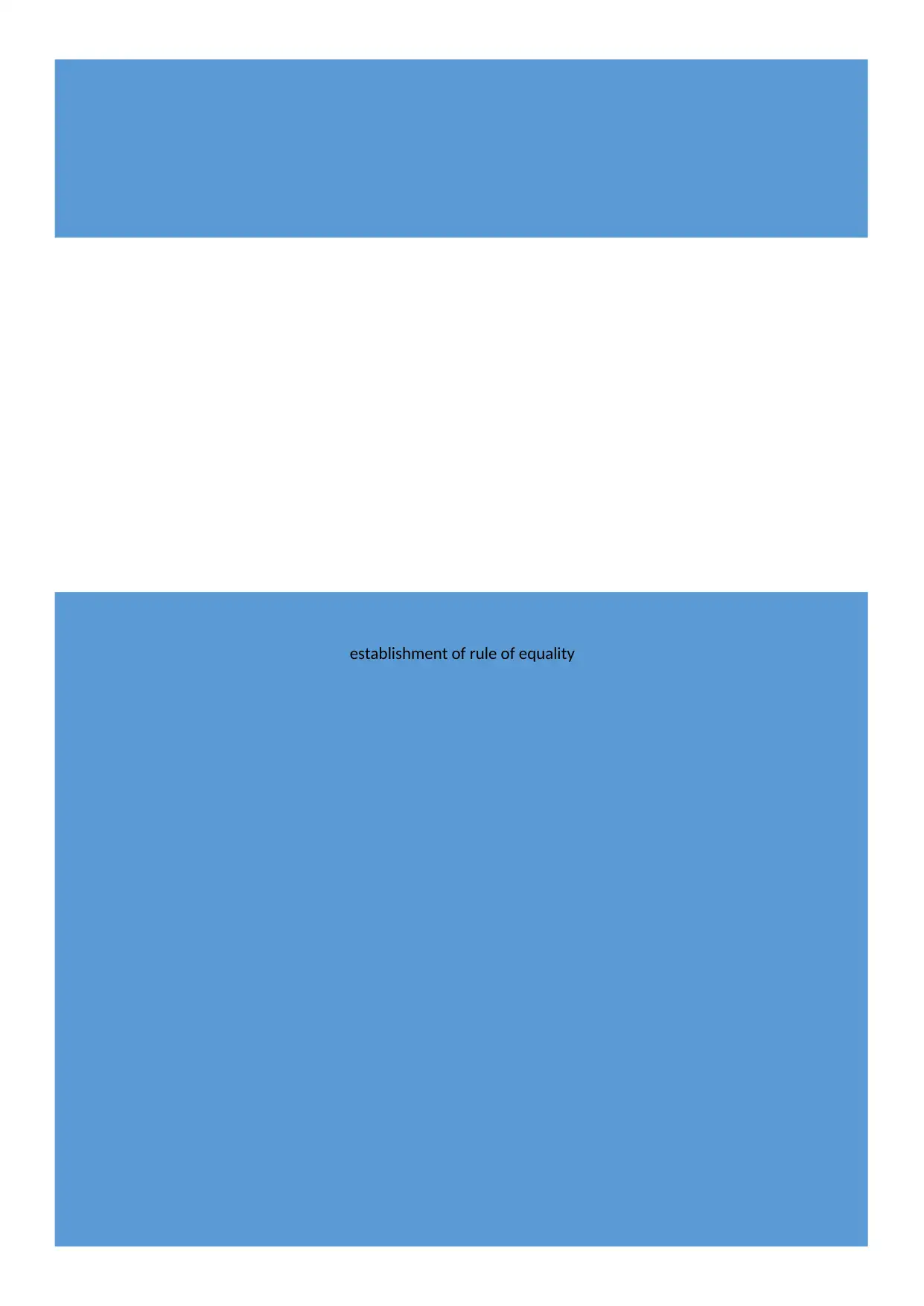
establishment of rule of equality
Paraphrase This Document
Need a fresh take? Get an instant paraphrase of this document with our AI Paraphraser
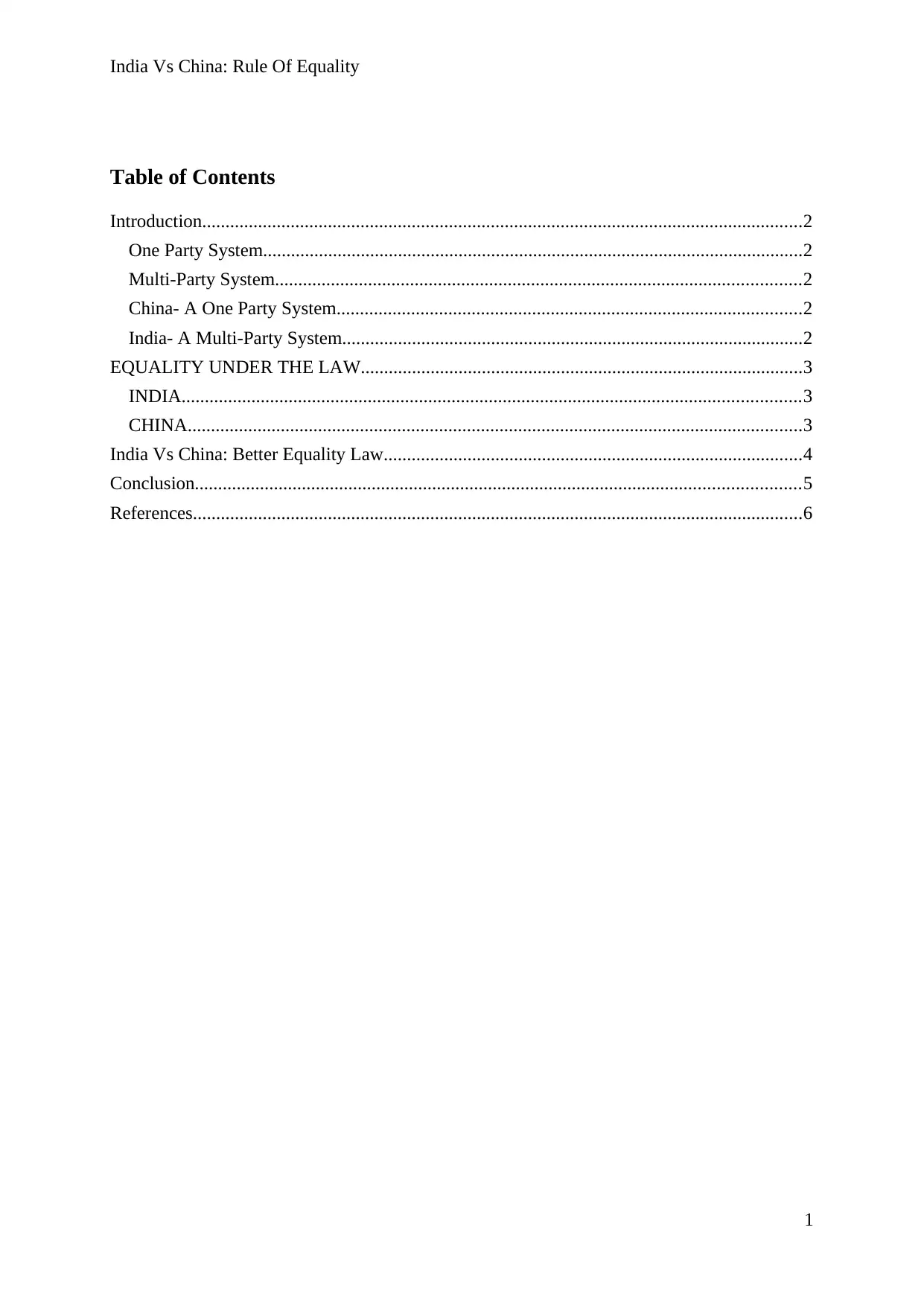
India Vs China: Rule Of Equality
Table of Contents
Introduction.................................................................................................................................2
One Party System....................................................................................................................2
Multi-Party System.................................................................................................................2
China- A One Party System....................................................................................................2
India- A Multi-Party System...................................................................................................2
EQUALITY UNDER THE LAW...............................................................................................3
INDIA.....................................................................................................................................3
CHINA....................................................................................................................................3
India Vs China: Better Equality Law..........................................................................................4
Conclusion..................................................................................................................................5
References...................................................................................................................................6
1
Table of Contents
Introduction.................................................................................................................................2
One Party System....................................................................................................................2
Multi-Party System.................................................................................................................2
China- A One Party System....................................................................................................2
India- A Multi-Party System...................................................................................................2
EQUALITY UNDER THE LAW...............................................................................................3
INDIA.....................................................................................................................................3
CHINA....................................................................................................................................3
India Vs China: Better Equality Law..........................................................................................4
Conclusion..................................................................................................................................5
References...................................................................................................................................6
1
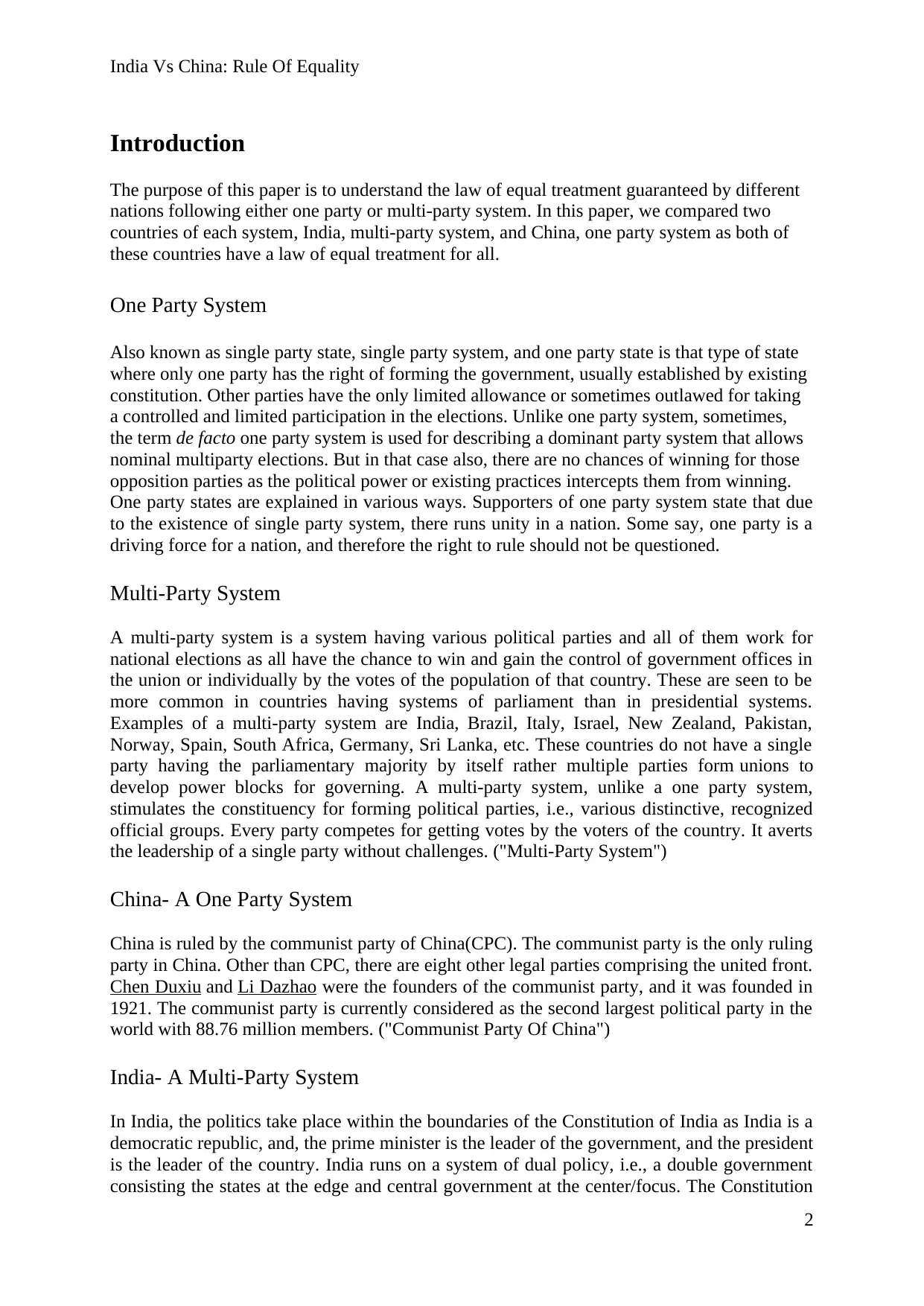
India Vs China: Rule Of Equality
Introduction
The purpose of this paper is to understand the law of equal treatment guaranteed by different
nations following either one party or multi-party system. In this paper, we compared two
countries of each system, India, multi-party system, and China, one party system as both of
these countries have a law of equal treatment for all.
One Party System
Also known as single party state, single party system, and one party state is that type of state
where only one party has the right of forming the government, usually established by existing
constitution. Other parties have the only limited allowance or sometimes outlawed for taking
a controlled and limited participation in the elections. Unlike one party system, sometimes,
the term de facto one party system is used for describing a dominant party system that allows
nominal multiparty elections. But in that case also, there are no chances of winning for those
opposition parties as the political power or existing practices intercepts them from winning.
One party states are explained in various ways. Supporters of one party system state that due
to the existence of single party system, there runs unity in a nation. Some say, one party is a
driving force for a nation, and therefore the right to rule should not be questioned.
Multi-Party System
A multi-party system is a system having various political parties and all of them work for
national elections as all have the chance to win and gain the control of government offices in
the union or individually by the votes of the population of that country. These are seen to be
more common in countries having systems of parliament than in presidential systems.
Examples of a multi-party system are India, Brazil, Italy, Israel, New Zealand, Pakistan,
Norway, Spain, South Africa, Germany, Sri Lanka, etc. These countries do not have a single
party having the parliamentary majority by itself rather multiple parties form unions to
develop power blocks for governing. A multi-party system, unlike a one party system,
stimulates the constituency for forming political parties, i.e., various distinctive, recognized
official groups. Every party competes for getting votes by the voters of the country. It averts
the leadership of a single party without challenges. ("Multi-Party System")
China- A One Party System
China is ruled by the communist party of China(CPC). The communist party is the only ruling
party in China. Other than CPC, there are eight other legal parties comprising the united front.
Chen Duxiu and Li Dazhao were the founders of the communist party, and it was founded in
1921. The communist party is currently considered as the second largest political party in the
world with 88.76 million members. ("Communist Party Of China")
India- A Multi-Party System
In India, the politics take place within the boundaries of the Constitution of India as India is a
democratic republic, and, the prime minister is the leader of the government, and the president
is the leader of the country. India runs on a system of dual policy, i.e., a double government
consisting the states at the edge and central government at the center/focus. The Constitution
2
Introduction
The purpose of this paper is to understand the law of equal treatment guaranteed by different
nations following either one party or multi-party system. In this paper, we compared two
countries of each system, India, multi-party system, and China, one party system as both of
these countries have a law of equal treatment for all.
One Party System
Also known as single party state, single party system, and one party state is that type of state
where only one party has the right of forming the government, usually established by existing
constitution. Other parties have the only limited allowance or sometimes outlawed for taking
a controlled and limited participation in the elections. Unlike one party system, sometimes,
the term de facto one party system is used for describing a dominant party system that allows
nominal multiparty elections. But in that case also, there are no chances of winning for those
opposition parties as the political power or existing practices intercepts them from winning.
One party states are explained in various ways. Supporters of one party system state that due
to the existence of single party system, there runs unity in a nation. Some say, one party is a
driving force for a nation, and therefore the right to rule should not be questioned.
Multi-Party System
A multi-party system is a system having various political parties and all of them work for
national elections as all have the chance to win and gain the control of government offices in
the union or individually by the votes of the population of that country. These are seen to be
more common in countries having systems of parliament than in presidential systems.
Examples of a multi-party system are India, Brazil, Italy, Israel, New Zealand, Pakistan,
Norway, Spain, South Africa, Germany, Sri Lanka, etc. These countries do not have a single
party having the parliamentary majority by itself rather multiple parties form unions to
develop power blocks for governing. A multi-party system, unlike a one party system,
stimulates the constituency for forming political parties, i.e., various distinctive, recognized
official groups. Every party competes for getting votes by the voters of the country. It averts
the leadership of a single party without challenges. ("Multi-Party System")
China- A One Party System
China is ruled by the communist party of China(CPC). The communist party is the only ruling
party in China. Other than CPC, there are eight other legal parties comprising the united front.
Chen Duxiu and Li Dazhao were the founders of the communist party, and it was founded in
1921. The communist party is currently considered as the second largest political party in the
world with 88.76 million members. ("Communist Party Of China")
India- A Multi-Party System
In India, the politics take place within the boundaries of the Constitution of India as India is a
democratic republic, and, the prime minister is the leader of the government, and the president
is the leader of the country. India runs on a system of dual policy, i.e., a double government
consisting the states at the edge and central government at the center/focus. The Constitution
2
⊘ This is a preview!⊘
Do you want full access?
Subscribe today to unlock all pages.

Trusted by 1+ million students worldwide
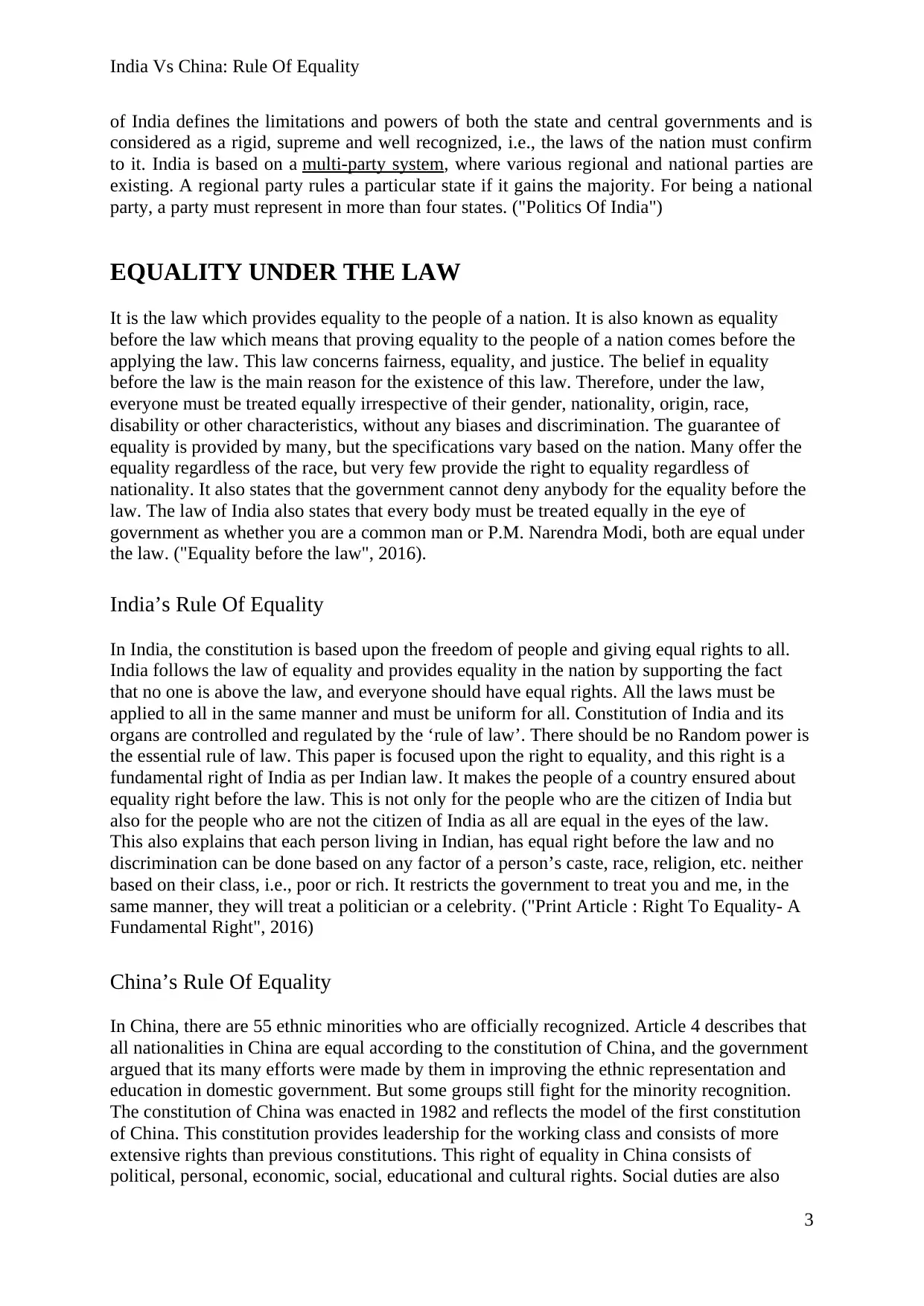
India Vs China: Rule Of Equality
of India defines the limitations and powers of both the state and central governments and is
considered as a rigid, supreme and well recognized, i.e., the laws of the nation must confirm
to it. India is based on a multi-party system, where various regional and national parties are
existing. A regional party rules a particular state if it gains the majority. For being a national
party, a party must represent in more than four states. ("Politics Of India")
EQUALITY UNDER THE LAW
It is the law which provides equality to the people of a nation. It is also known as equality
before the law which means that proving equality to the people of a nation comes before the
applying the law. This law concerns fairness, equality, and justice. The belief in equality
before the law is the main reason for the existence of this law. Therefore, under the law,
everyone must be treated equally irrespective of their gender, nationality, origin, race,
disability or other characteristics, without any biases and discrimination. The guarantee of
equality is provided by many, but the specifications vary based on the nation. Many offer the
equality regardless of the race, but very few provide the right to equality regardless of
nationality. It also states that the government cannot deny anybody for the equality before the
law. The law of India also states that every body must be treated equally in the eye of
government as whether you are a common man or P.M. Narendra Modi, both are equal under
the law. ("Equality before the law", 2016).
India’s Rule Of Equality
In India, the constitution is based upon the freedom of people and giving equal rights to all.
India follows the law of equality and provides equality in the nation by supporting the fact
that no one is above the law, and everyone should have equal rights. All the laws must be
applied to all in the same manner and must be uniform for all. Constitution of India and its
organs are controlled and regulated by the ‘rule of law’. There should be no Random power is
the essential rule of law. This paper is focused upon the right to equality, and this right is a
fundamental right of India as per Indian law. It makes the people of a country ensured about
equality right before the law. This is not only for the people who are the citizen of India but
also for the people who are not the citizen of India as all are equal in the eyes of the law.
This also explains that each person living in Indian, has equal right before the law and no
discrimination can be done based on any factor of a person’s caste, race, religion, etc. neither
based on their class, i.e., poor or rich. It restricts the government to treat you and me, in the
same manner, they will treat a politician or a celebrity. ("Print Article : Right To Equality- A
Fundamental Right", 2016)
China’s Rule Of Equality
In China, there are 55 ethnic minorities who are officially recognized. Article 4 describes that
all nationalities in China are equal according to the constitution of China, and the government
argued that its many efforts were made by them in improving the ethnic representation and
education in domestic government. But some groups still fight for the minority recognition.
The constitution of China was enacted in 1982 and reflects the model of the first constitution
of China. This constitution provides leadership for the working class and consists of more
extensive rights than previous constitutions. This right of equality in China consists of
political, personal, economic, social, educational and cultural rights. Social duties are also
3
of India defines the limitations and powers of both the state and central governments and is
considered as a rigid, supreme and well recognized, i.e., the laws of the nation must confirm
to it. India is based on a multi-party system, where various regional and national parties are
existing. A regional party rules a particular state if it gains the majority. For being a national
party, a party must represent in more than four states. ("Politics Of India")
EQUALITY UNDER THE LAW
It is the law which provides equality to the people of a nation. It is also known as equality
before the law which means that proving equality to the people of a nation comes before the
applying the law. This law concerns fairness, equality, and justice. The belief in equality
before the law is the main reason for the existence of this law. Therefore, under the law,
everyone must be treated equally irrespective of their gender, nationality, origin, race,
disability or other characteristics, without any biases and discrimination. The guarantee of
equality is provided by many, but the specifications vary based on the nation. Many offer the
equality regardless of the race, but very few provide the right to equality regardless of
nationality. It also states that the government cannot deny anybody for the equality before the
law. The law of India also states that every body must be treated equally in the eye of
government as whether you are a common man or P.M. Narendra Modi, both are equal under
the law. ("Equality before the law", 2016).
India’s Rule Of Equality
In India, the constitution is based upon the freedom of people and giving equal rights to all.
India follows the law of equality and provides equality in the nation by supporting the fact
that no one is above the law, and everyone should have equal rights. All the laws must be
applied to all in the same manner and must be uniform for all. Constitution of India and its
organs are controlled and regulated by the ‘rule of law’. There should be no Random power is
the essential rule of law. This paper is focused upon the right to equality, and this right is a
fundamental right of India as per Indian law. It makes the people of a country ensured about
equality right before the law. This is not only for the people who are the citizen of India but
also for the people who are not the citizen of India as all are equal in the eyes of the law.
This also explains that each person living in Indian, has equal right before the law and no
discrimination can be done based on any factor of a person’s caste, race, religion, etc. neither
based on their class, i.e., poor or rich. It restricts the government to treat you and me, in the
same manner, they will treat a politician or a celebrity. ("Print Article : Right To Equality- A
Fundamental Right", 2016)
China’s Rule Of Equality
In China, there are 55 ethnic minorities who are officially recognized. Article 4 describes that
all nationalities in China are equal according to the constitution of China, and the government
argued that its many efforts were made by them in improving the ethnic representation and
education in domestic government. But some groups still fight for the minority recognition.
The constitution of China was enacted in 1982 and reflects the model of the first constitution
of China. This constitution provides leadership for the working class and consists of more
extensive rights than previous constitutions. This right of equality in China consists of
political, personal, economic, social, educational and cultural rights. Social duties are also
3
Paraphrase This Document
Need a fresh take? Get an instant paraphrase of this document with our AI Paraphraser
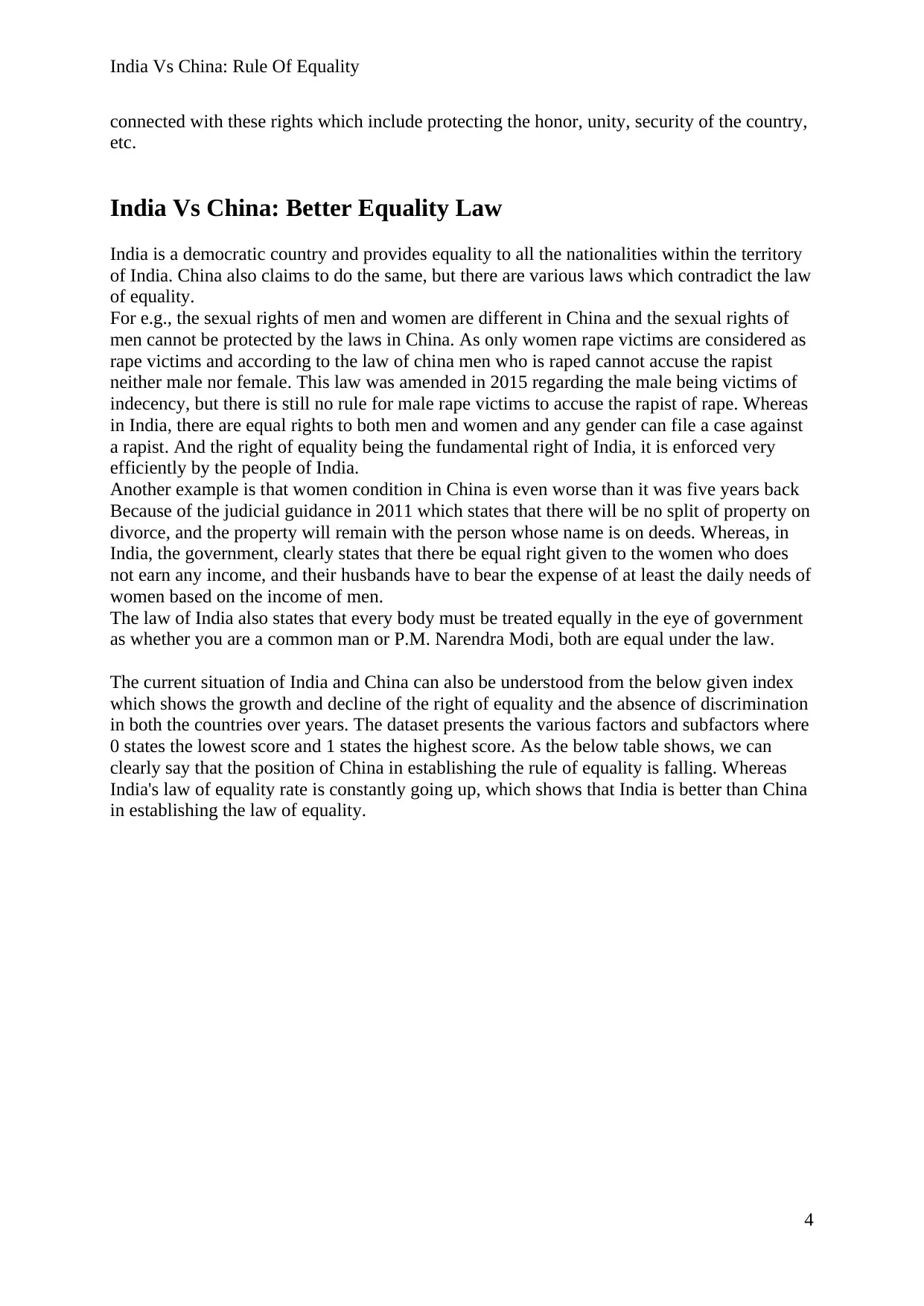
India Vs China: Rule Of Equality
connected with these rights which include protecting the honor, unity, security of the country,
etc.
India Vs China: Better Equality Law
India is a democratic country and provides equality to all the nationalities within the territory
of India. China also claims to do the same, but there are various laws which contradict the law
of equality.
For e.g., the sexual rights of men and women are different in China and the sexual rights of
men cannot be protected by the laws in China. As only women rape victims are considered as
rape victims and according to the law of china men who is raped cannot accuse the rapist
neither male nor female. This law was amended in 2015 regarding the male being victims of
indecency, but there is still no rule for male rape victims to accuse the rapist of rape. Whereas
in India, there are equal rights to both men and women and any gender can file a case against
a rapist. And the right of equality being the fundamental right of India, it is enforced very
efficiently by the people of India.
Another example is that women condition in China is even worse than it was five years back
Because of the judicial guidance in 2011 which states that there will be no split of property on
divorce, and the property will remain with the person whose name is on deeds. Whereas, in
India, the government, clearly states that there be equal right given to the women who does
not earn any income, and their husbands have to bear the expense of at least the daily needs of
women based on the income of men.
The law of India also states that every body must be treated equally in the eye of government
as whether you are a common man or P.M. Narendra Modi, both are equal under the law.
The current situation of India and China can also be understood from the below given index
which shows the growth and decline of the right of equality and the absence of discrimination
in both the countries over years. The dataset presents the various factors and subfactors where
0 states the lowest score and 1 states the highest score. As the below table shows, we can
clearly say that the position of China in establishing the rule of equality is falling. Whereas
India's law of equality rate is constantly going up, which shows that India is better than China
in establishing the law of equality.
4
connected with these rights which include protecting the honor, unity, security of the country,
etc.
India Vs China: Better Equality Law
India is a democratic country and provides equality to all the nationalities within the territory
of India. China also claims to do the same, but there are various laws which contradict the law
of equality.
For e.g., the sexual rights of men and women are different in China and the sexual rights of
men cannot be protected by the laws in China. As only women rape victims are considered as
rape victims and according to the law of china men who is raped cannot accuse the rapist
neither male nor female. This law was amended in 2015 regarding the male being victims of
indecency, but there is still no rule for male rape victims to accuse the rapist of rape. Whereas
in India, there are equal rights to both men and women and any gender can file a case against
a rapist. And the right of equality being the fundamental right of India, it is enforced very
efficiently by the people of India.
Another example is that women condition in China is even worse than it was five years back
Because of the judicial guidance in 2011 which states that there will be no split of property on
divorce, and the property will remain with the person whose name is on deeds. Whereas, in
India, the government, clearly states that there be equal right given to the women who does
not earn any income, and their husbands have to bear the expense of at least the daily needs of
women based on the income of men.
The law of India also states that every body must be treated equally in the eye of government
as whether you are a common man or P.M. Narendra Modi, both are equal under the law.
The current situation of India and China can also be understood from the below given index
which shows the growth and decline of the right of equality and the absence of discrimination
in both the countries over years. The dataset presents the various factors and subfactors where
0 states the lowest score and 1 states the highest score. As the below table shows, we can
clearly say that the position of China in establishing the rule of equality is falling. Whereas
India's law of equality rate is constantly going up, which shows that India is better than China
in establishing the law of equality.
4
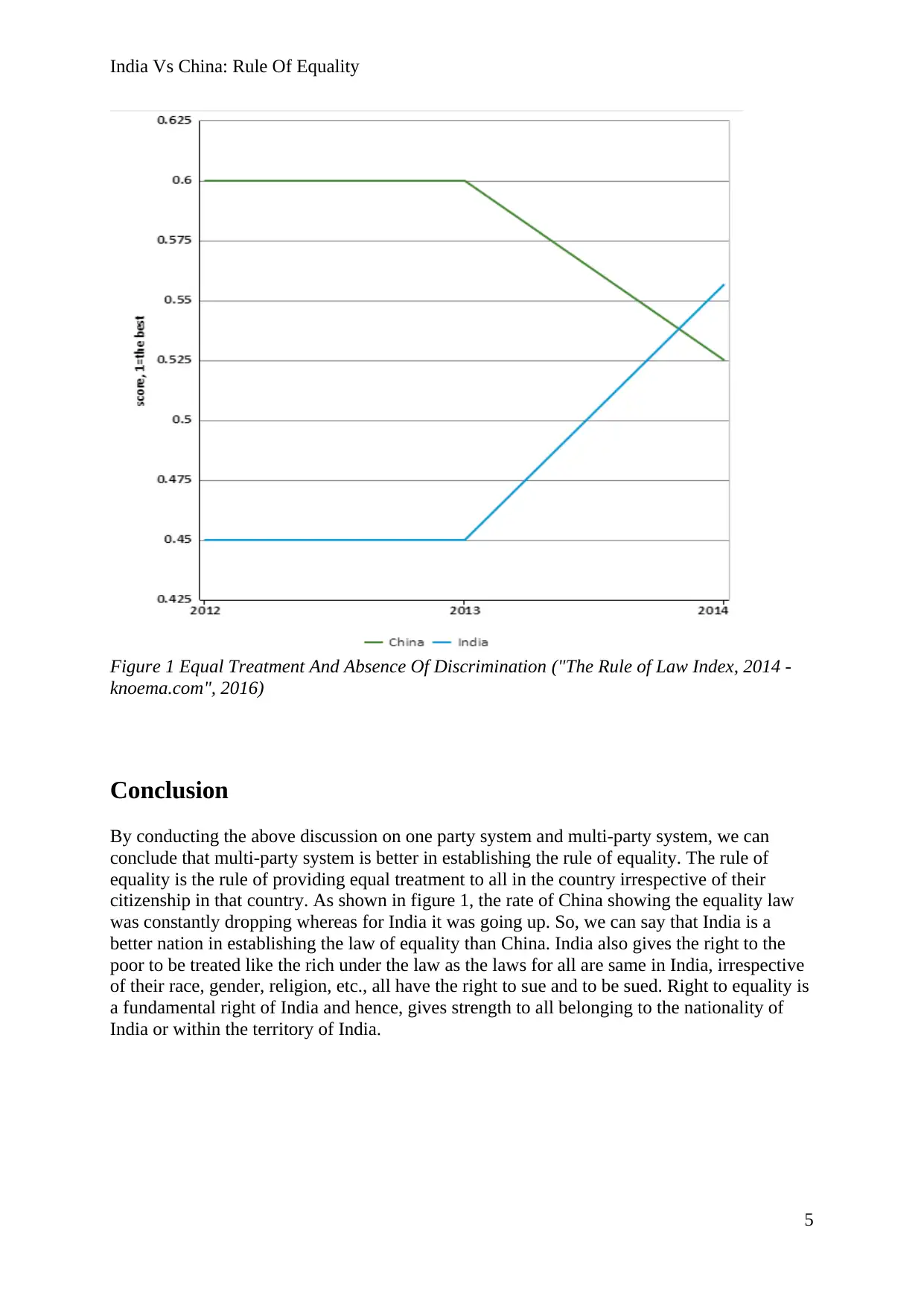
India Vs China: Rule Of Equality
Figure 1 Equal Treatment And Absence Of Discrimination ("The Rule of Law Index, 2014 -
knoema.com", 2016)
Conclusion
By conducting the above discussion on one party system and multi-party system, we can
conclude that multi-party system is better in establishing the rule of equality. The rule of
equality is the rule of providing equal treatment to all in the country irrespective of their
citizenship in that country. As shown in figure 1, the rate of China showing the equality law
was constantly dropping whereas for India it was going up. So, we can say that India is a
better nation in establishing the law of equality than China. India also gives the right to the
poor to be treated like the rich under the law as the laws for all are same in India, irrespective
of their race, gender, religion, etc., all have the right to sue and to be sued. Right to equality is
a fundamental right of India and hence, gives strength to all belonging to the nationality of
India or within the territory of India.
5
Figure 1 Equal Treatment And Absence Of Discrimination ("The Rule of Law Index, 2014 -
knoema.com", 2016)
Conclusion
By conducting the above discussion on one party system and multi-party system, we can
conclude that multi-party system is better in establishing the rule of equality. The rule of
equality is the rule of providing equal treatment to all in the country irrespective of their
citizenship in that country. As shown in figure 1, the rate of China showing the equality law
was constantly dropping whereas for India it was going up. So, we can say that India is a
better nation in establishing the law of equality than China. India also gives the right to the
poor to be treated like the rich under the law as the laws for all are same in India, irrespective
of their race, gender, religion, etc., all have the right to sue and to be sued. Right to equality is
a fundamental right of India and hence, gives strength to all belonging to the nationality of
India or within the territory of India.
5
⊘ This is a preview!⊘
Do you want full access?
Subscribe today to unlock all pages.

Trusted by 1+ million students worldwide
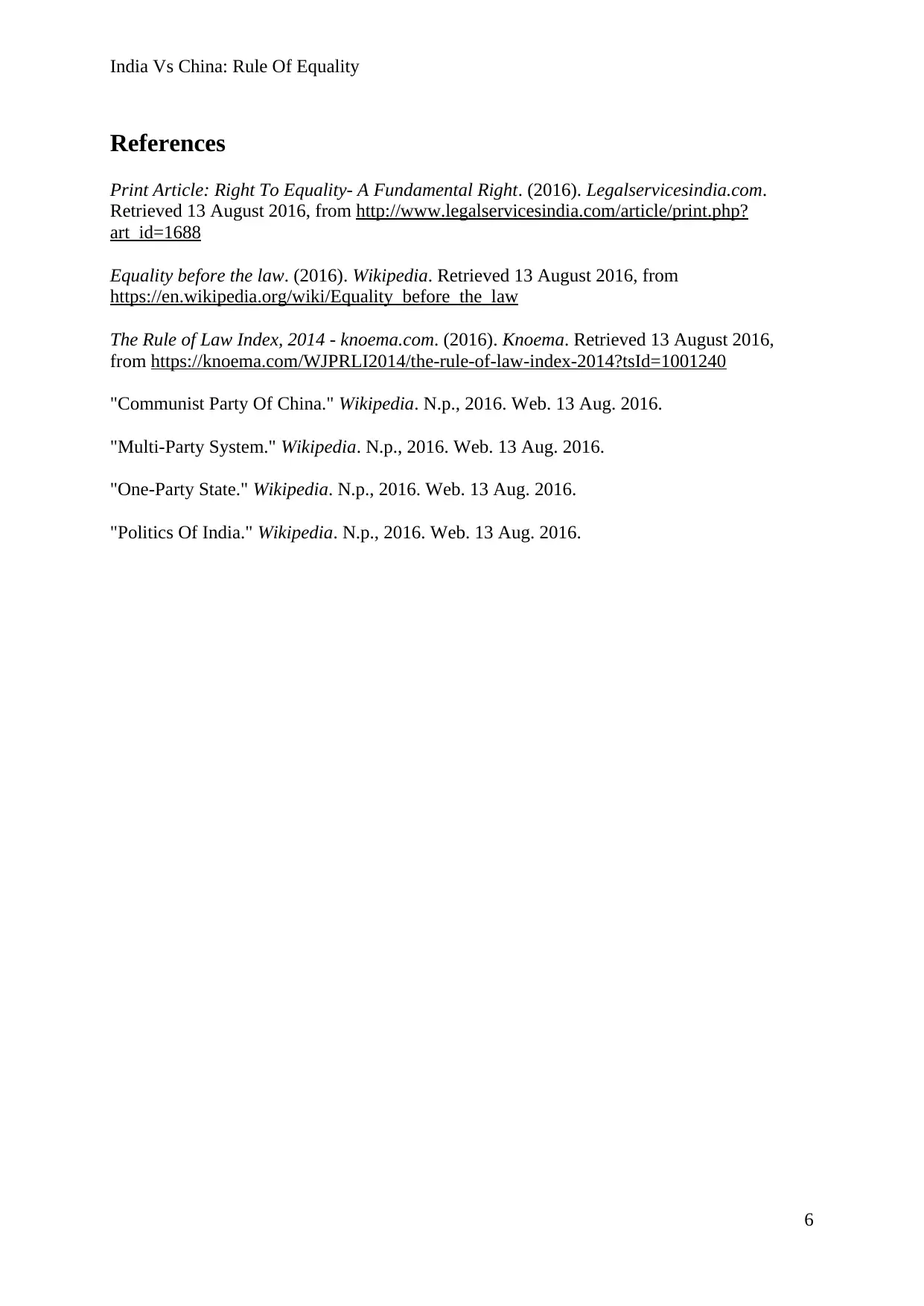
India Vs China: Rule Of Equality
References
Print Article: Right To Equality- A Fundamental Right. (2016). Legalservicesindia.com.
Retrieved 13 August 2016, from http://www.legalservicesindia.com/article/print.php?
art_id=1688
Equality before the law. (2016). Wikipedia. Retrieved 13 August 2016, from
https://en.wikipedia.org/wiki/Equality_before_the_law
The Rule of Law Index, 2014 - knoema.com. (2016). Knoema. Retrieved 13 August 2016,
from https://knoema.com/WJPRLI2014/the-rule-of-law-index-2014?tsId=1001240
"Communist Party Of China." Wikipedia. N.p., 2016. Web. 13 Aug. 2016.
"Multi-Party System." Wikipedia. N.p., 2016. Web. 13 Aug. 2016.
"One-Party State." Wikipedia. N.p., 2016. Web. 13 Aug. 2016.
"Politics Of India." Wikipedia. N.p., 2016. Web. 13 Aug. 2016.
6
References
Print Article: Right To Equality- A Fundamental Right. (2016). Legalservicesindia.com.
Retrieved 13 August 2016, from http://www.legalservicesindia.com/article/print.php?
art_id=1688
Equality before the law. (2016). Wikipedia. Retrieved 13 August 2016, from
https://en.wikipedia.org/wiki/Equality_before_the_law
The Rule of Law Index, 2014 - knoema.com. (2016). Knoema. Retrieved 13 August 2016,
from https://knoema.com/WJPRLI2014/the-rule-of-law-index-2014?tsId=1001240
"Communist Party Of China." Wikipedia. N.p., 2016. Web. 13 Aug. 2016.
"Multi-Party System." Wikipedia. N.p., 2016. Web. 13 Aug. 2016.
"One-Party State." Wikipedia. N.p., 2016. Web. 13 Aug. 2016.
"Politics Of India." Wikipedia. N.p., 2016. Web. 13 Aug. 2016.
6
1 out of 7
Related Documents
Your All-in-One AI-Powered Toolkit for Academic Success.
+13062052269
info@desklib.com
Available 24*7 on WhatsApp / Email
![[object Object]](/_next/static/media/star-bottom.7253800d.svg)
Unlock your academic potential
Copyright © 2020–2025 A2Z Services. All Rights Reserved. Developed and managed by ZUCOL.





